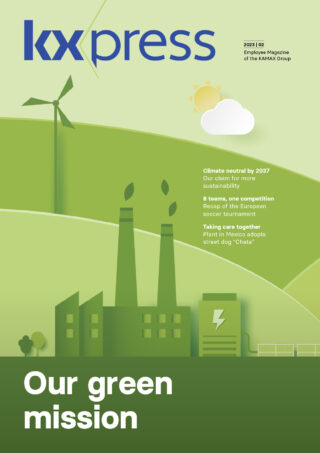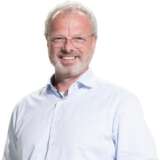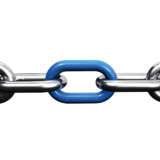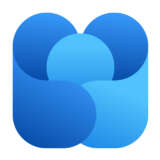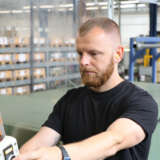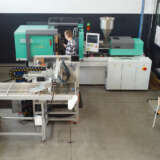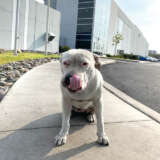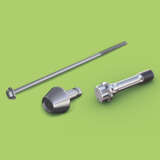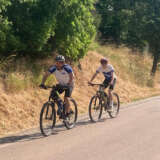Seeking out new markets
Left: The KXpanded bolt is used to fasten battery packs and electric motors, among other things.
Center: Our form part for street chisel is used to remove the asphalt from the street.
Right: We currently sell ultra-high-strength bolts mainly to automotive manufacturers, but they can also be used in wind turbines.
Making KAMAX less dependent on the automotive industry, developing new products and gaining access to new markets like construction equipment: these are the goals of our Business Development & Innovation department. We took a closer look at the work our colleagues are doing and explored why it is so important to the long-term success of KAMAX.
Mario Braun
VP Business Development & Innovation: He leads the entire department that bundles all initiatives to generate new business.
Robert Schreiter
Key Account Manager New Markets: He is responsible for acquiring new potential customers in other business areas outside the automotive industry.
Dennis Dutenhöfner
Manager Innovation Hub: With his team, he drives innovation, analyzes trends and develops product ideas for the coming years.
Mario Braun, Vice President of Business Development & Innovation, summed up the company’s situation: “Right now we are nearly 100 percent dependent on how many cars our customers are able to sell.” A full 30 percent of our business is based entirely on combustion engines – a product that, in Europe at least, is on its way to becoming obsolete. Starting in 2035, the EU will not allow any new vehicles with combustion engines to be registered. This means that it is even more important that KAMAX put its business on a broader footing, and that it gain new customers and enter new market sectors. Venturing beyond our current successful niche can open up new opportunities, and in the best case it can equip us to compensate for fluctuations in the automotive industry by increasing our sales in other industries. Mario Braun’s department is undertaking various measures to tackle this task, with eleven people in all working in the areas of Business Development, New Markets and Innovation.
Quantum leaps through innovation
When it comes to the development of new technologies, products or application concepts, the Innovation Hub (InnoHub) is the first port of call. What are the trends? What can we expect over the next ten to 30 years? What technologies are available to us? And what are the areas we can enter into today that will allow us to help shape the market tomorrow? This work takes place outside of our plants, and our colleagues begin by testing ideas on a smaller scale to see if they are even feasible. For every ten ideas, there might be one that is useful. For example, a special coating that makes our ultra-high-strength bolts (up to class 17.8U) even more resilient.
“Right now we are nearly 100 percent dependent on how many cars our customers are able to sell.”
Mario Braun, Vice President of Business Development & Innovation
As a result of the high tensile strength of the material, these have an increased susceptibility to hydrogen-induced brittle fractures. Corrosion gives rise to atomic hydrogen that penetrates the material, and causing it to fracture. Our colleagues at InnoHub have qualified an idea of a kind of coating that significantly reduces the susceptibility of bolts to this phenomenon – a quantum leap from the current situation. Once the functionality of this variant had been confirmed by various tests, the team passed their work on to the Research & Development department. The coating currently finds itself in the product development (BPD).
Once this has been completed, the process of shepherding the product to market readiness will also be the job of the Business Development team. While it may sound simple, this involves many different steps and entails close collaboration with the Application Technology and Sales areas. Business Development also helps out in the field of new markets, for example by identifying new areas in which existing products can be put to use. “New markets” refers to market and industry sectors that are found outside of the conventional automotive business. And these markets function differently than the ones with which KAMAX is familiar. According to Braun, “in the past we designed products to precisely suit the specifications of each individual customer.” A good example: we produce a chassis bolt that is only suitable for one Volkswagen model. These parts are purchased by the millions. The goal in new markets is to develop products that can be used by multiple customers.
Further team members in the New Markets department

Maximilian Kupka, Account Manager for New Markets

Chao Luo, Application Engineer for New Markets
Our working methods must change
There are a number of challenges: the way that we work has been shaped by our focus on the automotive industry. Braun: “When our colleagues in the plants hear that we want to take on production orders for small quantities or new customers, they are clearly skeptical.” And that is understandable – but the point is, that the marked mechanism differ! So even a smaller volume might be shipped in bigger lot’s sizes (Different than in Automotive) and also might show better profitability. At the same time, in the not-too-distant future, a number of our profitable products will no longer be needed on account of our customers’ move to electric motors. This makes it even more important that we remember: the decisions we make about the products we produce today will actively shape the future of KAMAX.
“If we do a really good job, we should be able to enter entirely new industry segments alongside our automotive customers.”
Mario Braun, Vice President of Business Development & Innovation
A positive example is offered by the development of ultra-high-strength bolts (KXtreme) just a few years ago – this is a segment that is growing continuously and which can be put to use in various areas. KAMAX bolts have already been successfully positioned in the automotive sector, with uses that include securing batteries and motors in electric vehicles. Braun: “Today we are discussing possible uses in the field of wind turbine gearboxes and slewing bearing fittings for construction equipment.”
To help them reach potential new customers, our colleagues are taking advantage of their networks, working with universities, and visiting conventions and trade fairs on a regular basis – they are also establishing partnerships with dealer networks. Manufacturers of agricultural machinery, for example, get all their materials from their partner dealers. “While it is true that we have contacts, we far too rarely succeed in submitting offers – and the biggest reason is that it takes us too long.” In an effort to change this, our team is currently working to define a new process for sales in new markets.
Street chisel blanks – a successful business model
One particular segment that the department is currently studying involves conventional wear parts for construction equipment. And these parts include street chisel blanks. These milling components are used in road work and are designed to roughen the asphalt. They have to be replaced every 500 meters, which means that large quantities are required. Because they are cold-formed parts that generally only need to be pressed and cleaned, road-milling bits are comparatively easy to manufacture and can be supplied to customers in large containers.
Mario Braun has a vision for the future: “If we do a really good job, we should be able to enter entirely new industry segments alongside our automotive customers.” To do this, all of our colleagues involved in these efforts need to be ready for change.
KXpress
